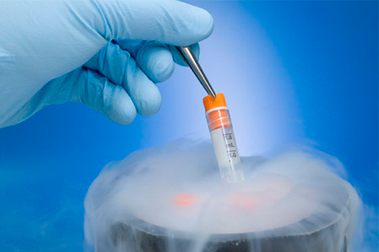|
Hyaluronic
Acid With Respect To Sperm Survival Post-Thaw:

Introduction:
The use of cryopreserved sperm is common in many Assisted
Reproductive Technology (ART) procedures. Some men
with very poor quality semen have their semen frozen
prior to In Vitro Fertilization (IVF) to assure an
abundance of sperm is available for fertilization.
Cancer patients frequently rely on semen cryopreservation
as a means to preserve their fertility just prior
to surgery, radiation and chemotherapy. Cryopreserved
donor sperm from “sperm banks” is available
for patients who have no sperm. One of the side effects
of freezing sperm is that much of it does not survive
the freeze/thaw process. In most instances, this is
not a tremendous issue because literally millions
of sperm are still alive after the thaw. In some cases,
however, the number of motile sperm is low and a very
significant portion of the sperm doesn’t survive
the thawing process.
An ongoing study at SRMS involves the use of Hyaluronic
Acid (HA) to increase the survival rate in thawed
sperm. The procedure is accomplished by incubating
the sperm in media containing variable concentrations
of HA prior to freezing. By hopefully increasing the
number of sperm that survive the thawing process,
the number of quality sperm available for various
ART procedures may be increased which should theoretically
increase the chances of fertilization and a positive
pregnancy test.
Abstract:
Increased Post Thaw Survival
Rates Observed In Semen Specimens Treated With Hyaluronic
Acid
Andrew Bhatnager, Ph.D., Corey Burke, B.S., C.L.S.,
Anna Hackenberg, Craig R. Sweet, M.D. (10/2008)
Hyaluronic acid (HA) is a naturally occurring mammalian
glycosaminoglycan. It is a found in the cumulus-oocyte
complex and seems to augment fertilization itself.
HA has also been proven to be beneficial for in
vitro mammalian embryo development with an increased
the post-thaw survival of cryopreserved embryos.
It is involved in numerous dynamic processes including
regulation of gene expression, cell proliferation
and cellular differentiation.
It was hypothesized that the addition of varying
concentrations of HA would increase the post-thaw
survival rate as well as the percentage of rapidly
progressing human sperm.
A dose response curve was first established to determine
the most effective concentration of HA to be used
in semen preparation and freezing media. Specimens
were obtained from men presenting for routine semen
analysis at an infertility clinic. Only those specimens
with normal motility (>50%) and progression (a-b)
were used in the study. The specimens first underwent
a gradient separation technique followed by a single
wash in modified Human Tubal Fluid (mHTF). The motility
and progression values were obtained using a Computerized
Assisted Sperm Analyzer (CASA). The overlying supernatant
was removed and the pelleted sperm were divided
into three equal portions. One portion was resuspended
in mHTF (control), a second was re-suspended in
mHTF containing 0.001 g/ml of HA while the third
was re-suspended in mHTF containing 0.025 g/ml of
HA. All samples were incubated at 37¾C for one hour
and then centrifuged. Equal parts of Test Yolk Buffer
containing the same original concentration of HA
were added. The specimens were then frozen in liquid
nitrogen using a controlled slow freeze method.
Specimens were later thawed at room temperature
and washed in HA-free mHTF. Post-thaw results were
obtained following the wash and repeated at 1 hour
later using the computer assisted semen analysis
(CASA).
In specimens incubated with 0.001 g/mL HA, the overall
post-thaw motility was 45.5% with 18.7% of the sperm
found to be rapidly moving. The sperm in the control
group (no HA added) had a reduced motility of 37.5%
with 16.5% rapidly moving sperm. Preliminary results,
therefore, reveal an increase in survival and progression
rates in those specimens that were frozen using
a concentration of 0.001 g/ml of HA.
Dr. Sweet’s Comments:
It is common for fewer
than half of the sperm will survive after thawing.
Any technique that can improve the survival rate
would be welcome. Increasing the function of the
sperm through increased motility would also be ideal.
In this preliminary study, HA was found to do just
that. While more research certainly needs to be
done, this is an important study that could have
implications for a whole host of cryopreservation
procedures.
|






